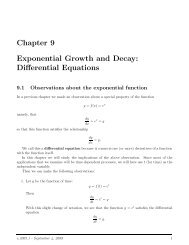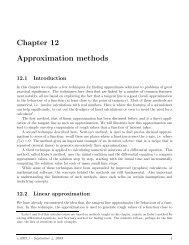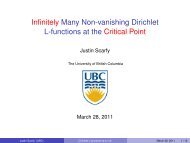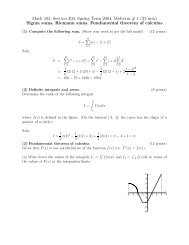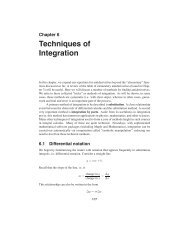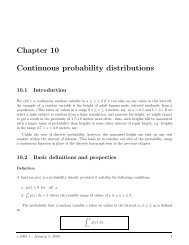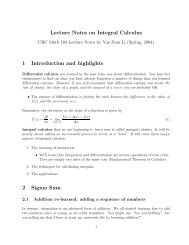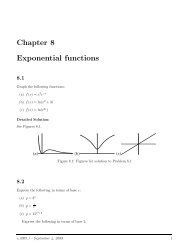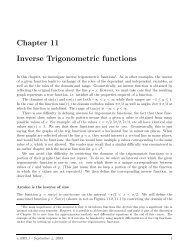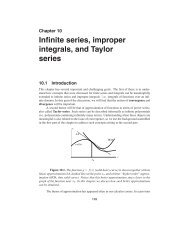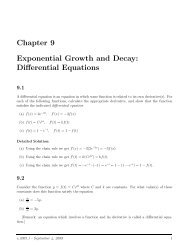Chapter 8 Exponential functions - Ugrad.math.ubc.ca
Chapter 8 Exponential functions - Ugrad.math.ubc.ca
Chapter 8 Exponential functions - Ugrad.math.ubc.ca
Create successful ePaper yourself
Turn your PDF publications into a flip-book with our unique Google optimized e-Paper software.
Math 102 Problems <strong>Chapter</strong> 8<br />
Suppose that when two fish are at distance x > 0 from one another, they are attracted with<br />
“force” F a and repelled with “force” F r given by:<br />
F a = Ae −x/a<br />
F r = Re −x/r<br />
where A, R, a, r are positive constants. A, R are related to the magnitudes of the forces, and a, r to<br />
the spatial range of these effects.<br />
(a) Show that at the distance x = a the first function has fallen to (1/e) times its value at the<br />
origin. (Re<strong>ca</strong>ll e ≈ 2.7.) For what value of x does the second function fall to (1/e) times<br />
its value at the origin? Note that this is the reason why a, r are <strong>ca</strong>lled spatial ranges of the<br />
forces.<br />
(b) It is generally assumed that R > A and r < a. Interpret what this mean about the comparative<br />
effects of the forces and sketch a graph showing the two <strong>functions</strong> on the same set of axes.<br />
(c) Find the distance at which the forces exactly balance. This is <strong>ca</strong>lled the comfortable distance<br />
for the two individuals.<br />
(d) If either A or R changes so that the ratio R/A decreases, does the comfortable distance<br />
increase or decrease? (Give reason.)<br />
(e) Similarly comment on what happens to the comfortable distance if a increases or r decreases.<br />
8.18 Seed distribution<br />
The density of seeds at a distance x from a parent tree is observed to be<br />
D(x) = D 0 e −x2 /a 2 ,<br />
where a > 0, D 0 > 0 are positive constants. Insects that eat these seeds tend to congregate near<br />
the tree so that the fraction of seeds that get eaten is<br />
F(x) = e −x2 /b 2<br />
where b > 0. (Remark: These <strong>functions</strong> are <strong>ca</strong>lled Gaussian or Normal distributions. The parameters<br />
a, b are related to the “width” of these bell-shaped curves.) The number of seeds that survive<br />
(i.e. are produced and not eaten by insects) is<br />
S(x) = D(x)(1 − F(x))<br />
Determine the distance x from the tree at which the greatest number of seeds survive.<br />
v.2005.1 - September 4, 2009 6



